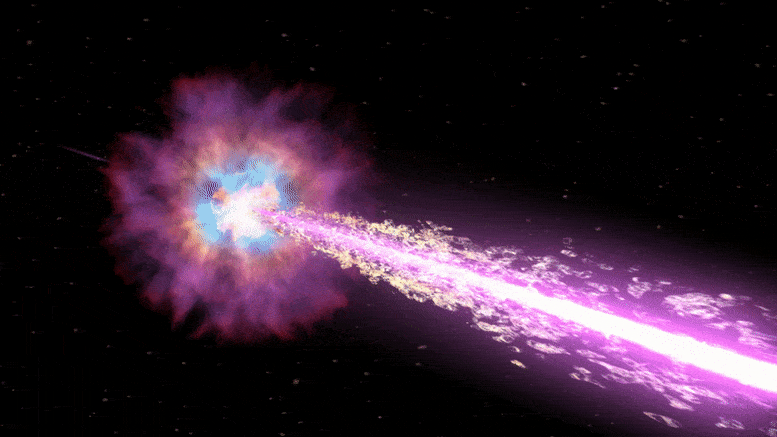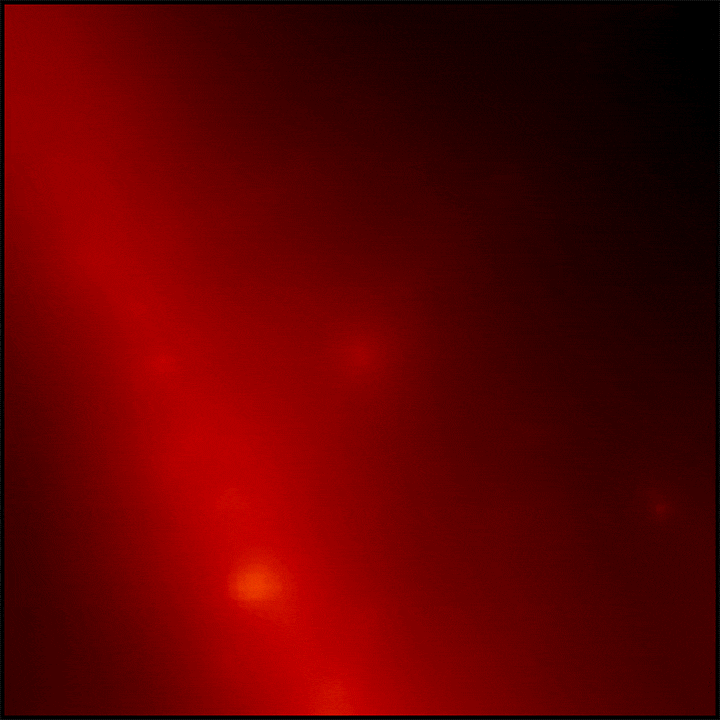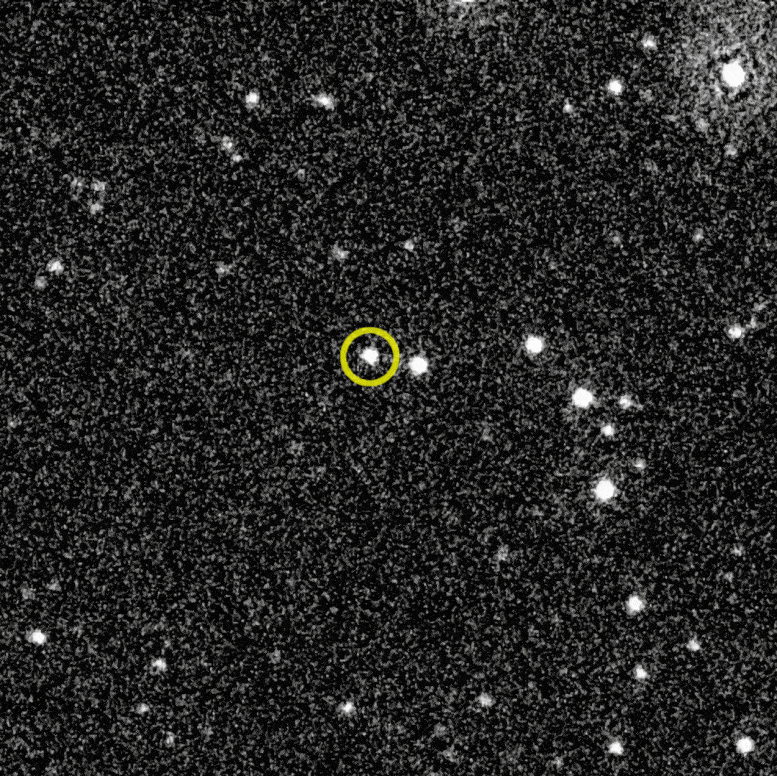
Astronomen glauben, dass GRB 221009A die Geburt eines neuen Schwarzen Lochs darstellt, das sich im Kern eines kollabierenden Sterns gebildet hat. In dieser Abbildung treibt ein Schwarzes Loch mächtige Partikelstrahlen an, die sich der Lichtgeschwindigkeit nähern. Jets durchdringen den Stern und senden Röntgen- und Gammastrahlen aus, während sie durch den Weltraum strömen. Bildnachweis: NASA/Swift/Cruz de Wilde
Die NASA-Missionen Swift und Fermi entdecken eine außergewöhnliche kosmische Explosion
Ein ungewöhnlich heller und energiereicher Strahlungsimpuls fegte am Sonntag, dem 9. Oktober, zur Überraschung von Astronomen auf der ganzen Welt über die Erde. Die intensive Emission stammte von einem Gammastrahlenausbruch (GRB) – der stärksten Klasse von Explosionen im Universum – die zu den hellsten bekannten Ereignissen gehören.
Vor einer Woche, an einem Sonntagmorgen ET, durchquerte eine Welle von Röntgen- und Gammastrahlen das Sonnensystem. Verursachen Sie, dass die integrierten Detektoren ausgelöst werden[{“ attribute=““>NASA’s Fermi Gamma-ray Space Telescope, Neil Gehrels Swift Observatory, and Wind spacecraft, as well as others. Around the world, telescopes were turned to the site to study the aftermath, and new observations continue.

Swift’s X-Ray Telescope captured the afterglow of GRB 221009A about an hour after it was first detected. The bright rings form as a result of X-rays scattered from otherwise unobservable dust layers within our galaxy that lie in the direction of the burst. Credit: Credit: NASA/Swift/A. Beardmore (University of Leicester)
Called GRB 221009A, the explosion provided an unexpectedly exciting start to the 10th Fermi Symposium, a gathering of gamma-ray astronomers now underway in Johannesburg, South Africa. “It’s safe to say this meeting really kicked off with a bang – everyone’s talking about this,” said Judy Racusin, a Fermi deputy project scientist at NASA’s Goddard Space Flight Center in Greenbelt, Maryland, who is attending the conference.
Astronomen glauben, dass GRB 221009A eine Wiedergeburt darstellt[{“ attribute=““>black hole formed within the heart of a collapsing star. As illustrated here, the black hole drives powerful jets of particles traveling near the speed of light. The jets pierce through the star, emitting X-rays and gamma rays as they stream into space. Credit: NASA/Swift/Cruz deWilde
Originating from the direction of the constellation Sagitta, the signal traveled an estimated 1.9 billion years to reach Earth. Many astronomers believe it represents the birth cry of a new black hole, one that formed in the heart of a massive star collapsing under its own weight. In these circumstances, a developing black hole drives powerful jets of particles traveling near the speed of light. The energetic jets pierce through the star, emitting X-rays and gamma rays as they stream into space.

This sequence constructed from Fermi Large Area Telescope data reveals the sky in gamma rays centered on the location of GRB 221009A. Each frame shows gamma rays with energies greater than 100 million electron volts (MeV), where brighter colors indicate a stronger gamma-ray signal. In total, they represent more than 10 hours of observations. The glow from the midplane of our Milky Way galaxy appears as a wide diagonal band. The image is about 20 degrees across. Credit: NASA/DOE/Fermi LAT Collaboration
The burst also provided a long-awaited inaugural observing opportunity for a link between two experiments on the International Space Station (ISS) – NASA’s NICER X-ray telescope and a Japanese detector called the Monitor of All-sky X-ray Image (MAXI). Activated in April, the connection is dubbed the Orbiting High-energy Monitor Alert Network (OHMAN). It allows NICER to rapidly turn to outbursts detected by MAXI, actions that previously required intervention by scientists on the ground.
“OHMAN provided an automated alert that enabled NICER to follow up within three hours, as soon as the source became visible to the telescope,” said Zaven Arzoumanian, the NICER science lead at Goddard. “Future opportunities could result in response times of a few minutes.”

Images taken in visible light by Swift’s Ultraviolet/Optical Telescope show how the afterglow of GRB 221009A (circled) faded over the course of about 10 hours. The explosion appeared in the constellation Sagitta and occurred 1.9 billion years ago. The image is about 4 arcminutes across. Credit: NASA/Swift/B. Cenko
The light from this ancient explosion brings with it valuable new insights into stellar collapse, the birth of a black hole, the behavior and interaction of matter near the speed of light, the conditions in a distant galaxy – and much more. Astronomers may not detect another GRB this bright for decades.
Fermi’s Large Area Telescope (LAT) detected the burst for more than 10 hours, according to a preliminary analysis. One reason for the burst’s exceptional brightness and longevity is that, for a GRB, it lies relatively close to us.
“This burst is much closer than typical GRBs, which is exciting because it allows us to detect many details that otherwise would be too faint to see,” said Roberta Pillera, a Fermi LAT Collaboration member who led initial communications about the burst and a doctoral student at the Polytechnic University of Bari, Italy. “But it’s also among the most energetic and luminous bursts ever seen regardless of distance, making it doubly exciting.”

„Pop-Kulturaholic. Web-Nerd. Engagierter Social-Media-Praktiker. Reisefanatiker. Schöpfer. Food-Guru.“

/cdn.vox-cdn.com/uploads/chorus_asset/file/24924650/236780_Google_AntiTrust_Trial_Custom_Art_CVirginia__0000_4.png)



More Stories
Die Federal Aviation Administration fordert eine Untersuchung des Misserfolgs bei der Landung der Falcon-9-Rakete von SpaceX
Identische Dinosaurier-Fußabdrücke auf zwei Kontinenten entdeckt
SpaceX startet 21 Starlink-Satelliten mit einer Falcon 9-Rakete von Cape Canaveral aus – SpaceflightNow